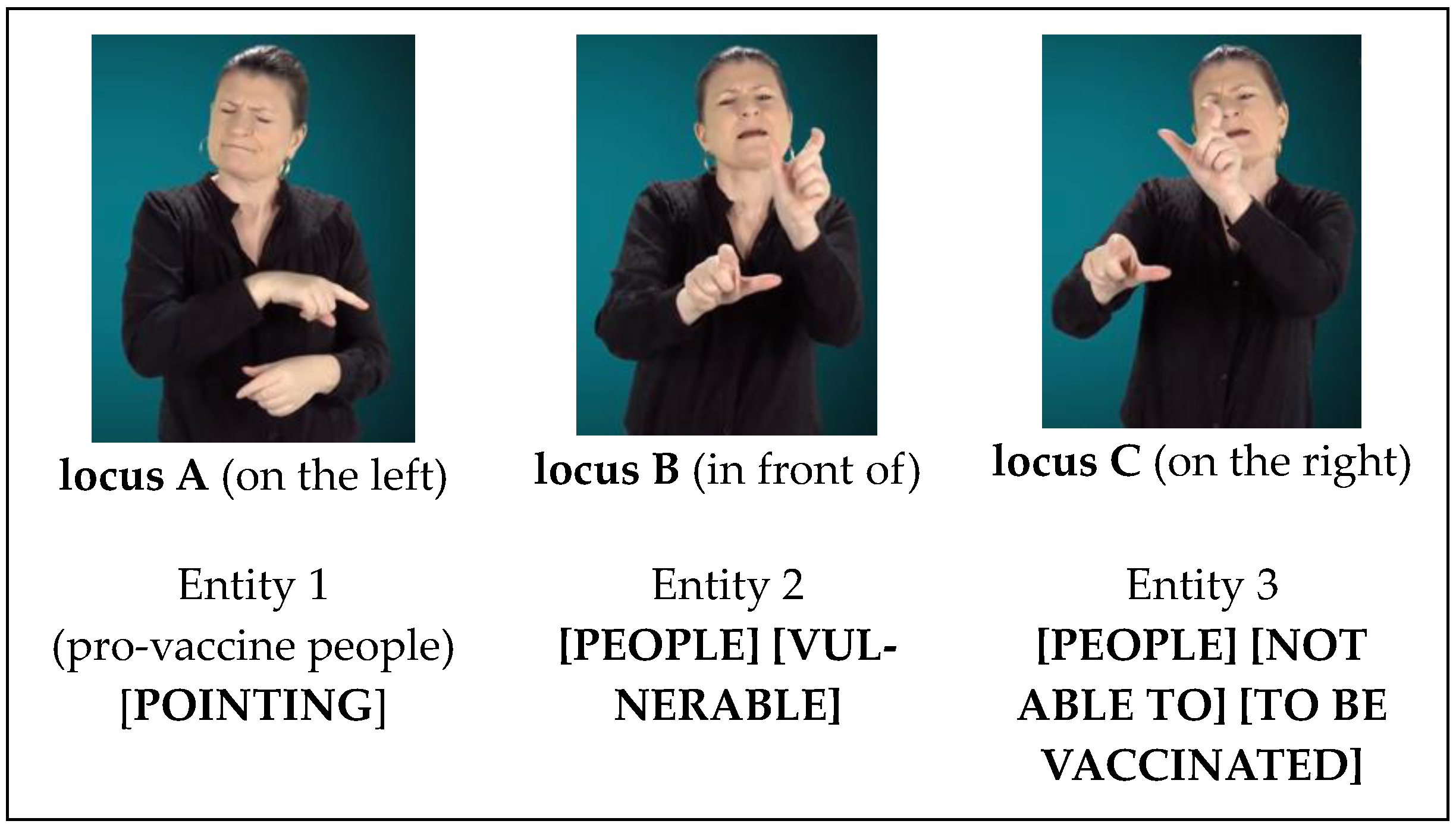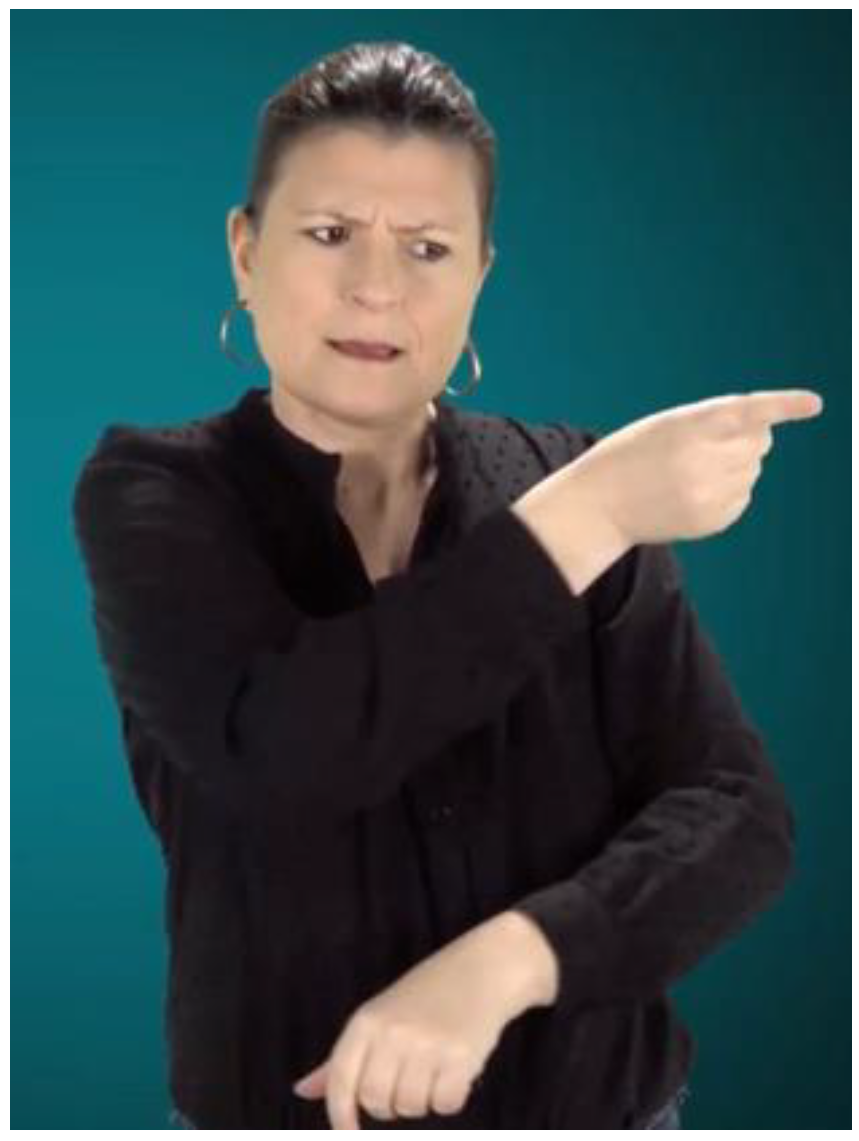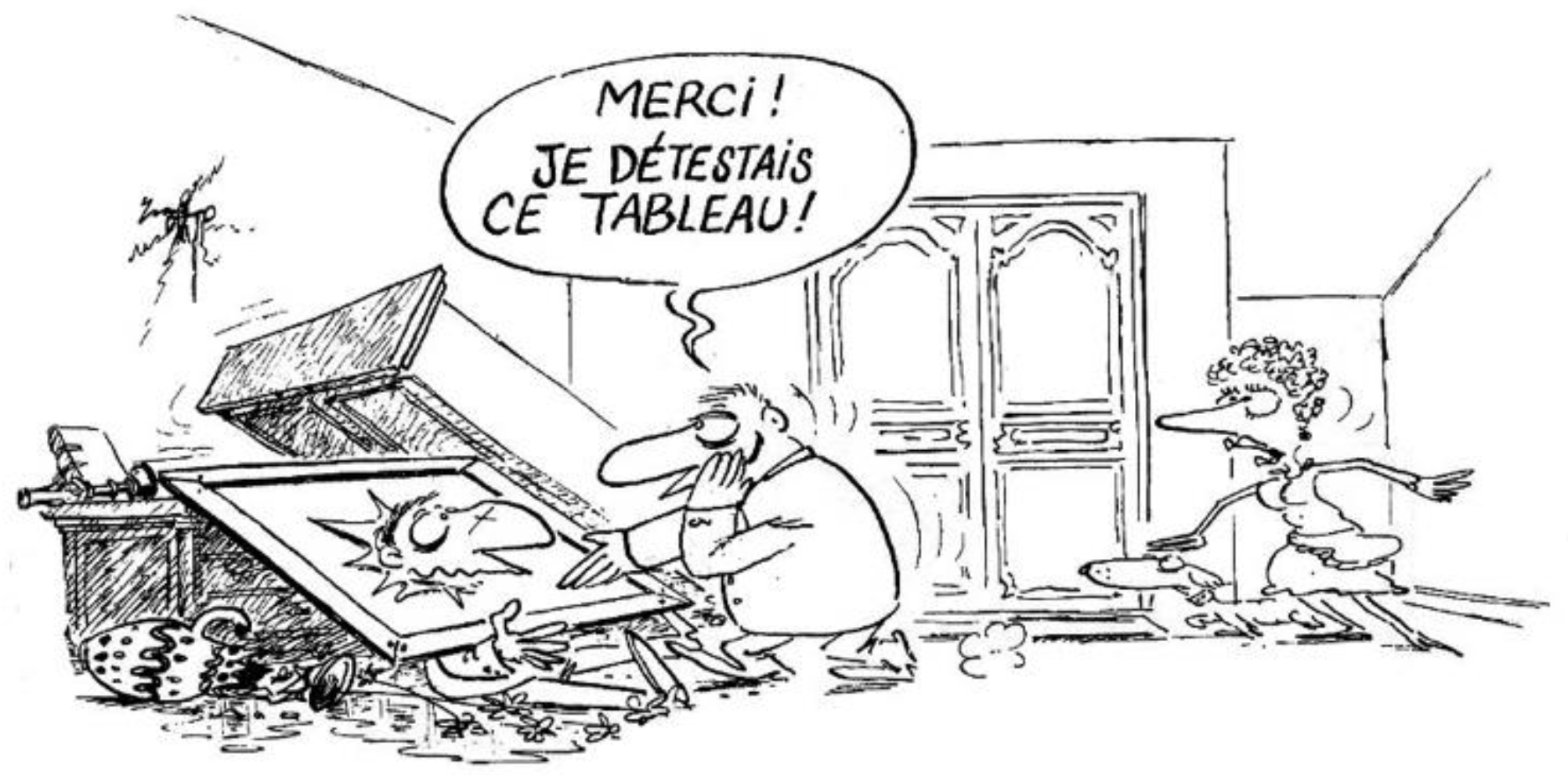Deaf Signers’ Processing of the Sentence: An Indicator of Their Specific Pathway to the Written Word?
Abstract
1. Introduction
2. Preliminary Remarks
2.1. A Specific Pathway to the Written Word in Deaf People
2.2. Linguistic Specificities of LSF (L1) Compared with Written French (L2)
| (1) | Ces personnes insistent sur le fait que c’est une preuve de solidarité pour protéger les personnes les plus vulnérables, ainsi que les personnes qui ne peuvent pas se faire vacciner. |
| These people insist that this is a demonstration of solidarity to protect the most vulnerable people, as well as those who cannot be vaccinated. |
- Entity 1: anaphoric use of an anterior NP with a demonstrative determiner (“the pro-vaccine people” > “these people”);
- Entity 2: use of a superlative (the most vulnerable);
- Entity 3: use of a restrictive relative clause, introduced by the relative pronoun “who” (only people who cannot be vaccinated are taken into account).
2.3. The Issue of Linguistic Transfer from a Sign Language to a Written Vocal Language
3. Materials and Methods
3.1. Study 1: Cross-Sectional Study of Written French Narratives in Deaf People
3.2. Study 2: Relative Clause Processing by Deaf Signers Proficient in Written French
4. Results
4.1. Study 1: Differences between Deaf and Hearing People in Their Command of Sentences and Clauses
4.1.1. Visual Markers of the Sentence: Standard and Idiosyncratic Usage
| (2) | entre dibute les deux copains par jalousie que achete le beau tableau ventre par une femme eclate que le tableau cassé, une femme mettre en colère en plus leur chien aboit. (Mathieu G1) |
| [between argument the two buddies out of jealousy that to buy the pretty painting etc.14] |
| (3) | Ce Couple étant partir en vacances—ayant acheter un Joli Tableau de Souvenir—ceci à leurs Retour chez eux—les mois suivants sont passés. le Tableau était mis sur un Mur de la Salle à Manger—par un clou qui a fallu du Temps pour l’enfoncer—ayant été fissuré par la force de frappe du Marteau. (David G2) |
| [This Couple being to go on vacation—having buy a Pretty Souvenir Painting—this on their Return at home—the following months passed. the Painting was placed on a Dining Room Wall—by a nail who took a long Time to sink it—having been cracked by the force of the Hammer blow]. |
4.1.2. Internal Organization of the Sentence
- -
- The non-repetition of a referent in subject or object position, as in (4), where the word “armoire” is both a complement of “dire” and the subject of “bouger”:
| (4) | j’aurais dit pour l’armoire était déjà bougé (Simon G2) [I would have said for the wardrobe was already moved] |
- -
- The absence of a verb, which does not necessarily hinder comprehension, as in (5):
| (5) | C’est très très cher le tableau, peinture en huile (Cédric) [It’s very, very expensive the painting, oil paint] |
- -
- An idiosyncratic use of the tool word “que”, often with a coordinative value, or expressing cause or consequence (and not subordination), as is the case in (6), (7), and (8):
| (6) | eclate que le tableau cassé (Mathieu G1) [explodes that the painting broken] |
| (7) | avec surprise que le voisin ait trouvé le tableau plein de défauts (David) [with surprise that the neighbor found the painting full of defects] |
| (8) | très en colère, furieux qu’il enlève le tableau (David) [very angry, furious that he removes the painting] |
4.2. Study 2: Intra-Sentence Organization in Advanced-Level Deaf Learners of Written French
| (9) | Lorsque je marchais droit vers elles, je les avais aperçu de loin et qu’elles me voyaient aussi. |
| [When I walked straight towards them, I saw them from afar and that they saw me too.] | |
| (10) | …j’appelais à une fille de droite de m’aider que j’ai exprimé ce que c’est la réponse de Numéro 1. |
| […I was calling to a girl of the right to help me that I expressed what it is Number 1’s response.] |
| (11) | On voit que la violence crée l’autre violence. Ceux qui ont dit de ne pas avoir la violence alors qu’ils le font! |
| [We can see that violence creates other violence. Those who said not to have violence when they are doing it!] |
| (12) | Tous les soirs, une personne qui joue de la musique très fort et dérange les habitants de l’immeuble. |
| [Every evening, someone who plays music very loudly and disturbs the building’s inhabitants] |
5. Discussion
Author Contributions
Funding
Institutional Review Board Statement
Informed Consent Statement
Data Availability Statement
Acknowledgments
Conflicts of Interest
| 1 | On this point, see Garcia and Sallandre (2013), Bianchini (2012), Antinoro Pizzuto and Garcia (2023). |
| 2 | “Deaf signers” are deaf people who use sign language as their main language (L1). |
| 3 | In the literature, the terms “sign languages” and “spoken languages” are generally used to designate, respectively, languages with a visual–gestural modality and those with an audio–vocal modality. Following Antinoro Pizzuto et al. (2007), we opt for the term “vocal languages” for the latter. Indeed, SLs are just as “spoken” as so-called “spoken” languages, on the one hand, and, on the other, this allows us to unambiguously contrast the term “oral” with that of “written”. |
| 4 | Our L1/L2 distinction is more cognitive than chronological. Indeed, although most signing deaf people were firstly exposed to a vocal language, sign language may have taken on such a large cognitive role that it quickly took on the role of their first language. |
| 5 | In our (functionalist) linguistic approach, we consider the typological gap between SLs and VLs to be significant due to the iconicity that leads to linguistic structures that are highly specific to SLs. |
| 6 | We consider a good reader to have a minimum level of B2 according to the CEFR descriptor: “Can read with a large degree of independence, adapting style and speed of reading to different texts and purposes, and using appropriate reference sources selectively. Has a broad active reading vocabulary, but may experience some difficulty with low-frequency idioms.” https://rm.coe.int/chapter-3-communicative-language-activities-and-strategies/1680a084b4 (accessed on 15 December 2023). |
| 7 | For the “matrix clause”, we follow the definition given by Riegel et al. ([1994] 2009): the matrix is the higher-level constituent in which the subordinate is embedded. |
| 8 | The majority of (at least) bivalent verbs in SLs are so-called directional verbs (or “argument verbs” in the literature): they are specified by the fact that the movement of the sign is modified to mark the actant–agent (starting point of the movement) and the actant–patient or beneficiary (end point of the movement). For debates on this notion, see (Garcia et al. 2022). |
| 9 | The three space dimensions plus the temporal dimension. |
| 10 | Standard written French would be “l’anniversaire d’Evelyne”. Given the existence of the possessive case in English, which precisely places the possessor first, it is difficult to give an English equivalent. |
| 11 | |
| 12 | Translation of what the main character says: “Thanks! I hated this painting!”. |
| 13 | The project involved seven countries: Spain, France, Iceland, Israel, the Netherlands, Sweden, and the United States. It was entitled “Developing literacy in different contexts and different languages” and was funded by the Spencer Foundation (USA). |
| 14 | Such a sequence of pseudo-words is difficult to reproduce in full in English, and it would be of little relevance here. |
| 15 | We refer here to the Common European Framework of Reference for Languages (CEFR), which organizes L2 proficiency into six levels: A1, A2, B1, B2, C1, C2. |
References
- Abbou, Victor. 2017. Une clé sur le monde. Aubière: Eyes Editions. [Google Scholar]
- Antinoro Pizzuto, Elena, and Brigitte Garcia. 2023. Coming back to the issue of the graphic representation of Sign Language (SL) discourse in SL linguistics. In Signed Language and Gesture Research in Cognitive Linguistics. Edited by Terry Janzen and Barbara Shaffer. Berlin: De Gruyter Mouton, pp. 49–74. [Google Scholar]
- Antinoro Pizzuto, Elena, Paola Pietrandrea, and Raffaele Simone, eds. 2007. Verbal and Signed Languages. Comparing Structures, Constructs and Methodologies. Berlin: de Gryuter Mouton. [Google Scholar]
- Beaujard, Laurence, and Marie Perini. 2020. The Role and Place of Sign Language in Deaf Youth’s Access to Literacy: Contributions of a Cross-Review of ASL-English and LSF-French Research. Frontiers in Communication 7: 810724. [Google Scholar] [CrossRef]
- Bélanger, Nathalie N., and Keith Rayner. 2015. What eye movements reveal about deaf readers. Current Directions in Psychological Science 24: 220–26. [Google Scholar] [CrossRef]
- Bélanger, Nathalie N., Michelle Lee, and Elisabeth R. Schotter. 2017. Young Skilled Deaf Readers Have an Enhanced Perceptual Span in Reading. The Quarterly Journal of Experimental Psychology 71: 291–301. [Google Scholar] [CrossRef] [PubMed]
- Bélanger, Nathalie N., Timothy J. Slattery, Rachel I. Mayberry, and Keith Rayner. 2012. Skilled deaf readers have an enhanced perceptual span in reading. Psychological Science 23: 816–23. [Google Scholar] [CrossRef] [PubMed]
- Bianchini, Claudia Savina. 2012. Analyse Métalinguistique de L’émergence d’un Système D’écriture des Langues des Signes: SignWriting et Son Application à la Langue des Signes Italienne (LIS). Ph.D. thesis, 2012, University of Paris 8, Saint-Denis, France, Università degli Studi di Perugia, Perugia, Italy. [Google Scholar]
- Clark, Diane M., Gizelle L. Gilbert, and Melissa L. Anderson. 2011. Morphological knowledge and decoding skills of deaf readers. Psychology 2: 109–16. [Google Scholar] [CrossRef]
- Cuxac, Christian. 2000. La Langue des Signes Française; les Voies de l’Iconicité. Faits de Langues, n° 15–16. Paris: Ophrys. [Google Scholar]
- Dadone, Adrien. forthcoming. Les subordonnées relatives en «que» et «qui»: Analyse d’un point de résistance dans l’accès à la littératie d’adultes sourds locuteurs de la langue des signes française (LSF) langue 1 et proposition didactique de remédiation. Saint-Denis: University of Paris 8.
- Daigle, Daniel, and Colette Dubuisson. 1998. Que peut-on conclure des recherches portant sur l’écriture. In Lecture, écriture et surdité: Visions actuelles et Nouvelles Perspectives. Edited by Colette Dubuisson and Daniel Daigle. Montréal: Les Editions Logiques, pp. 131–51. [Google Scholar]
- Eckman, Fred R. 1977. Markedness and the contrastive analysis hypothesis. Language Learning 27: 315–30. [Google Scholar] [CrossRef]
- Ellis, Rod. 2015. Understanding Second Language Acquisition, 2nd ed. Oxford and New York: Oxford University Press. [Google Scholar]
- Emmorey, Karen. 2002. Language, Cognition, and the Brain: Insights from Sign Language Research. Mahwah: Lawrence Erlbaum Associates. [Google Scholar]
- Emmorey, Karen. 2020. The Neurobiology of reading differs for deaf and hearing adults. In Oxford Handbook of Deaf Studies in Learning and Cognition. Edited by Marc Marschark and Harry Knoors. Oxford and New York: Oxford University Press, pp. 346–59. [Google Scholar] [CrossRef]
- Garcia, Brigitte, Antonio Balvet, and Marie-Thérèse L’huillier. 2022. Accord/Pas accord dans les verbes directionnels en langue des signes: Est-ce vraiment la bonne question? Travaux Linguistiques du CerLiCO 33: 93–116. [Google Scholar]
- Garcia, Brigitte, and Marie Perini. 2010. Normes en jeu et jeu des normes dans les deux langues en présence chez les sourds locuteurs de la Langue des Signes Française (LSF). Langage et Société 131: 75–94. [Google Scholar] [CrossRef]
- Garcia, Brigitte, and Marie-Anne Sallandre. 2013. Transcription systems for sign languages: A sketch of the different graphical representations of sign language and their characteristics. In Body—Language—Communication, An International Handbook on Multimodality in Human Interaction. Edited by Cornelia Müller, Allan Cienki, Ellen Fricke, Silva Ladewig, David McNeill and Sedinha Tessendorf. (HSK 38/1). Berlin: de Gruyter Mouton, vol. 1, pp. 1125–40. [Google Scholar]
- Hellqvist Herdy, Birgitta. 2010. La subordination dans la production écrite en L2. Étude sur l’acquisition de la subordination en français L2 chez 10 lycéens suédophones. Master’s dissertation, Linnaeus University, Växjö, Sweden. [Google Scholar]
- Hoffmeister, Robert, Jon Henner, Catherine Caldwell-Harris, and Rama Novogrodsky. 2022. Deaf children’s ASL vocabulary and ASL syntax knowledge supports English knowledge. Journal of Deaf Studies and Deaf Education 27: 37–47. [Google Scholar] [CrossRef] [PubMed]
- Hyltenstam, Kenneth. 1984. The use of typological markedness conditions as predictors in second language acquisition: The case of pronominal copies in relative clauses. In Second Languages: A Cross-Linguistic Perspective. Edited by Roger W. Andersen. Rowley: Newbury House, pp. 39–58. [Google Scholar]
- Jarvis, Scott, and Aneta Pavlenko. 2008. Crosslinguistic Influence in Language and Cognition. New York and London: Routledge. [Google Scholar] [CrossRef]
- Kellerman, Eric. 1989. The imperfect conditional: Fossilization, cross-linguistic influence and natural tendencies in a foreign language setting. In Bilingualism across the Lifespan: Aspects of Acquisition, Maturity and Loss. Edited by Kenneth Hyltenstam and Loraine K. Obler. Cambridge: Cambridge University Press, pp. 87–115. [Google Scholar]
- Liu, Hsiu Tan. 2022. Taiwanese Sign Language and Chinese reading comprehension: Exploring relationships. Deafness & Education International 24: 203–23. [Google Scholar] [CrossRef]
- Mayberry, Rachel I., Alex A. Giudice, and Amy M. Liebermann. 2011. Reading Achievement in Relation to Phonological Coding and Awareness in Deaf Readers: A Meta-Analysis. Journal of Deaf Studies and Deaf Education 16: 164–88. [Google Scholar] [CrossRef] [PubMed]
- Millet, Agnès. 2008. Les sourds et l’écrit—Éducation, représentations, pratiques: Le français sourd existe-t-il ? In Variétés, Variations & Formes du Français. Edited by Olivier Bertrand and Isabelle Schaffner. Palaiseau: Les Editions de L’école Polytechnique, pp. 277–93. [Google Scholar]
- Neuville, Helen J. 1991. Neurobiology of cognitive and language processing: Effects of Early Experience. In Brain Maturation and Cognitive Development. Edited by Kathleen R. Gibson and Anne C. Petersen. New York: Aldine de Gruyter, pp. 355–80. [Google Scholar] [CrossRef]
- Perini, Marie. 2013. Que peuvent nous apprendre les productions écrites des sourds? Analyse de lectes écrits de personnes sourdes pour une contribution à la didactique du français écrit en formation d’adultes. Ph.D. thesis, University of Paris 8, Saint-Denis, France. [Google Scholar]
- Pontecorvo, Clotilde, ed. 1997. Writing Development. An Interdisciplinary View. Philadelphia: John Benjamins. [Google Scholar]
- Riegel, Martin, Jean-Christophe Pellat, and René Rioul. 2009. Grammaire Méthodique du Français. Paris: Presses Universitaires de France. First published 1994. [Google Scholar]
- Vincent-Durroux, Laurence. 2004. Référenciation et opérations d’individuation dans la langue orale des sourds profonds, anglophones et francophones. Cycnos 16: 99–110. [Google Scholar]







Disclaimer/Publisher’s Note: The statements, opinions and data contained in all publications are solely those of the individual author(s) and contributor(s) and not of MDPI and/or the editor(s). MDPI and/or the editor(s) disclaim responsibility for any injury to people or property resulting from any ideas, methods, instructions or products referred to in the content. |
© 2024 by the authors. Licensee MDPI, Basel, Switzerland. This article is an open access article distributed under the terms and conditions of the Creative Commons Attribution (CC BY) license (https://creativecommons.org/licenses/by/4.0/).
Share and Cite
Périni, M.; Dadone, A.; Garcia, B. Deaf Signers’ Processing of the Sentence: An Indicator of Their Specific Pathway to the Written Word? Languages 2024, 9, 69. https://doi.org/10.3390/languages9030069
Périni M, Dadone A, Garcia B. Deaf Signers’ Processing of the Sentence: An Indicator of Their Specific Pathway to the Written Word? Languages. 2024; 9(3):69. https://doi.org/10.3390/languages9030069
Chicago/Turabian StylePérini, Marie, Adrien Dadone, and Brigitte Garcia. 2024. "Deaf Signers’ Processing of the Sentence: An Indicator of Their Specific Pathway to the Written Word?" Languages 9, no. 3: 69. https://doi.org/10.3390/languages9030069
APA StylePérini, M., Dadone, A., & Garcia, B. (2024). Deaf Signers’ Processing of the Sentence: An Indicator of Their Specific Pathway to the Written Word? Languages, 9(3), 69. https://doi.org/10.3390/languages9030069







